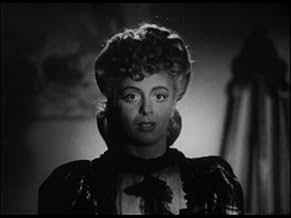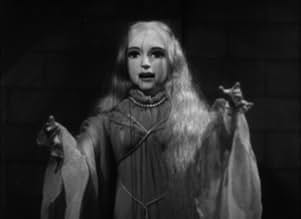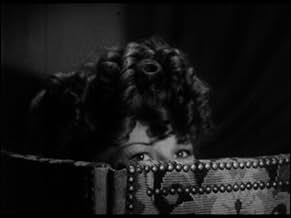NOTE IMDb
5,9/10
2,3 k
MA NOTE
Ajouter une intrigue dans votre langueIn Paris, an artist hires portrait models, and after he finishes their portraits, he strangles them.In Paris, an artist hires portrait models, and after he finishes their portraits, he strangles them.In Paris, an artist hires portrait models, and after he finishes their portraits, he strangles them.
- Réalisation
- Scénario
- Casting principal
Ludwig Stössel
- Jean Lamarte
- (as Ludwig Stossel)
Harry Cording
- Policeman
- (non crédité)
Frank Darien
- Inquiry Judge
- (non crédité)
Bess Flowers
- Courtroom Spectator
- (non crédité)
Mabel Forrest
- Woman
- (non confirmé)
- (non crédité)
Eddie Hall
- Paul
- (non crédité)
Avis à la une
Paris ,France , a tormented painter and puppeteer called Gaston Morrell (one of John Carradine's best vehicles) has a psychopatic urge to strangle gorgeous women . As he contacts Parisian women through his paintings posing as models he seduces and eventually kills them in order to carry out his dark purports . Among those getting the ending curtain call from "bluebeard" (is a type of serial killer ; specifically, it is a man who murders his wives or lovers , this type is named after the fictional "Bluebeard") are Francine Lutien , Lucille Lutien and Renee Claremont .
This chiller is based on lady killer Henry-Denise Landru who seduced and murdered several women . The flick realized Noir style packs thrills , chills , drama , suspense and a lot of murders . Good acting by John Carradine as an artist hires portrait models, and after he finishes their portraits, he strangles them . It features John Carradine's own favorite performance . Furthermore , there appears Jean Parker as Lucille Lutien and Nils Asther and Inspector Jacques . And film debut of actress Sonia Sorel -Mrs. John Carradine- , who went on to do several more titles for director Edgar G. Ulmer.
The failure of the original copyright holder to renew the film's copyright resulted in it falling into public domain, meaning that virtually anyone could duplicate and sell a VHS/DVD copy of the film. Therefore, many of the versions of this film available on the market are either severely and usually badly edited and/or of extremely poor quality, having been duplicated from second- or third-generation or more copies of the film . Eugen Schüfftan was actually the director of photography but could not be credited on screen because he was not yet a member of the cinematographer's union . So he was credited as production designer, the job actually done by director Edgar G. Ulmer, while the camera operator Jockey Arthur Feindel was credited as director of photography . This Noir film was professionally directed by Edgar G Ulmer , being filmed in six days . Edgar was born on September 17, 1904 in Olmütz, Moravia, Czech Republic as Edgar George Ulmer. He was a director and writer, known for Satanás (1934), Detour (1945) and People on Sunday (1930) , Aníbal (1959) , The Amazing Transparent Man (1960) , Beyond the Time Barrier (1960) , among others .
Other films dealing with this known character , Henry ¨Bluebeard¨ Landru , -who was really father of various children, disposed and married 11 wives and killed them in order to feed his little family , being subsequently beheaded- , are the followings : ¨Bluebeard¨ (1901) by George Melies ; ¨Monsieur Verdoux¨ (1947) with Charles Chaplin and Martha Ryer ; ¨Bluebeard's 10 honeymoon¨ by W.L. Wilder with George Sanders , Patricia Roc and Corinne Calvet ; ¨Bluebeard¨(1963) by Claude Chabrol with Charles Denner , Stephane Audran , Danielle Darrieux , Michele Morgan and Hildegarde Neff ; soporific remake titled ¨Bluebeard¨(1972) by Edward Dmytryck with Richard Burton, Joey Heatherton , Rachel Welch , Sybil Danning , Natahalie Delon , Virna Lisi ; and ¨¨Bluebeard¨(2009) by Catherine Breillat with Dominique Thomas and Lola Creton .
This chiller is based on lady killer Henry-Denise Landru who seduced and murdered several women . The flick realized Noir style packs thrills , chills , drama , suspense and a lot of murders . Good acting by John Carradine as an artist hires portrait models, and after he finishes their portraits, he strangles them . It features John Carradine's own favorite performance . Furthermore , there appears Jean Parker as Lucille Lutien and Nils Asther and Inspector Jacques . And film debut of actress Sonia Sorel -Mrs. John Carradine- , who went on to do several more titles for director Edgar G. Ulmer.
The failure of the original copyright holder to renew the film's copyright resulted in it falling into public domain, meaning that virtually anyone could duplicate and sell a VHS/DVD copy of the film. Therefore, many of the versions of this film available on the market are either severely and usually badly edited and/or of extremely poor quality, having been duplicated from second- or third-generation or more copies of the film . Eugen Schüfftan was actually the director of photography but could not be credited on screen because he was not yet a member of the cinematographer's union . So he was credited as production designer, the job actually done by director Edgar G. Ulmer, while the camera operator Jockey Arthur Feindel was credited as director of photography . This Noir film was professionally directed by Edgar G Ulmer , being filmed in six days . Edgar was born on September 17, 1904 in Olmütz, Moravia, Czech Republic as Edgar George Ulmer. He was a director and writer, known for Satanás (1934), Detour (1945) and People on Sunday (1930) , Aníbal (1959) , The Amazing Transparent Man (1960) , Beyond the Time Barrier (1960) , among others .
Other films dealing with this known character , Henry ¨Bluebeard¨ Landru , -who was really father of various children, disposed and married 11 wives and killed them in order to feed his little family , being subsequently beheaded- , are the followings : ¨Bluebeard¨ (1901) by George Melies ; ¨Monsieur Verdoux¨ (1947) with Charles Chaplin and Martha Ryer ; ¨Bluebeard's 10 honeymoon¨ by W.L. Wilder with George Sanders , Patricia Roc and Corinne Calvet ; ¨Bluebeard¨(1963) by Claude Chabrol with Charles Denner , Stephane Audran , Danielle Darrieux , Michele Morgan and Hildegarde Neff ; soporific remake titled ¨Bluebeard¨(1972) by Edward Dmytryck with Richard Burton, Joey Heatherton , Rachel Welch , Sybil Danning , Natahalie Delon , Virna Lisi ; and ¨¨Bluebeard¨(2009) by Catherine Breillat with Dominique Thomas and Lola Creton .
7tavm
John Carradine had always considered his role as Gaston Morrell in Bluebeard as his favorite and since it's one of his few starring ones it's easy to see why. Director Edgar G. Ulmer makes the most of the low budget he had working for poverty row studio PRC in making one of the most atmospheric horror films of the '40s. Most of the supporting cast also do well here especially Jean Parker as Lucille who Gaston falls head over heels for and Ludwig Stossel as Jean Lamarte. The woman who played Renee, Sonia Sorel, would later marry Carradine and bear kids Keith and Robert with him. Iris Adrian lends some humor in a brief court sequence. Well worth seeking for old movie horror fans.
This telling of French serial killer Bluebeard (why was he called Bluebeard?) is notable for two reasons - one is John Carradine's haunting yet believable portrayal of a madman's psyche, and the other is for Edgar G. Ulmer's ability to create mood and even grandeur on a tiny budget. While Carradine's acting skills have never been in question, his over-the-top scene stealing in many small roles would make one approach him with caution in a leading role. However, Carradine manages to restrain himself enough to never grow old or cumbersome in the role, while simultaneously delivering his lines memorably - leading to the excellent final crescendo. The plot never tires, the direction is masterful, the ensemble acting (especially the devious art dealer Lamarte) far better than expected, and the final feeling one of satisfaction. While all of this is unadulterated praise, the movie does appear a tad bit stagey (via budgetary concerns) at times, and also moves slowly at certain points. Despite this, Bluebeard is not merely an excellent time-waster, but a movie worthy of any viewer going out, renting, and popping in.
Over the years, there have been several notable versions dealing with the story of BLUEBEARD. The most critically acclaimed is Chaplin's MONSIEUR VERDOUX (1947). The most critically reviled is Richard Burton's BLUEBEARD from 1972. In 1960 George Sanders starred in BLUEBEARD'S 10 HONEYMOONS which is an effective, though hard to find, little B movie.
That has not been the case with PRC's BLUEBEARD (1944) starring John Carradine which has been available since the earliest days of TV. I first saw it in 1960 when I was 8. What has not been available, until now, is a decent print of the film. That has been corrected thanks to Kino Lorber with the release of this new Blu-ray.
PRC was known as the bottom rung of the "Poverty Row" ladder. Between 1939 and 1947 they cranked out an astonishing 179 films (that's 22 movies a year) which were shot in less than a week on a budget of less than $100K. Considering that, the look of their movies was very good but after numerous 16mm copies were used on TV, the visual and sonic quality sharply declined.
PRC's sound was never all that good to begin with and wear and tear on the prints made it even worse. I have seen BLUEBEARD many times and from a variety of sources but I have never seen a copy that looked and sounded this good and there are subtitles so at last you can understand what the puppets are singing.
Carradine (who was 38 at the time) gives his finest PRC performance as puppeteer Gaston Morell. He's low key and uses his baritone voice to great effect although that's obviously not him singing. For those who don't know, the opera is Gounod's FAUST. Director Edgar G. Ulmer loved classical music and worked it into his movies whenever he could. The other major theme comes from Mussorgsky's PICTURES AT AN EXHIBITION.
Other cast members include B movie queen Jean Parker as the heroine, former silent screen star Nils Asther as the Inspector, and Ludwig Stossel as the shady Art dealer. The film was photographed by Eugen Schufftan, the great German cameraman who did METROPOLIS, who was not credited due to Hollywood Union rules. The photography and the sets were supervised by director Ulmer.
In 19th century Paris, strangled woman are found floating in the Seine. The police have no clue. Could it be the kindly puppeteer who gives performances in the park? BLUEBEARD is not a horror film nor a mystery but rather a portrait of a tortured but compulsive killer whom we know will get caught in the end. It's the look of the film and Carradine's performance rather than the story that matters.
After years of bouncing around between various owners since PRC went under, BLUEBEARD now belongs to Paramount who has the resources to make it look and sound s good as it does on this Blu-ray. This is really the only way to see this movie. As more and more people are rediscovering the joys of physical media, this Kino Lorber disc is a must for any fan of 1940s B movie horrors...For more reviews visit The Capsule Critic.
That has not been the case with PRC's BLUEBEARD (1944) starring John Carradine which has been available since the earliest days of TV. I first saw it in 1960 when I was 8. What has not been available, until now, is a decent print of the film. That has been corrected thanks to Kino Lorber with the release of this new Blu-ray.
PRC was known as the bottom rung of the "Poverty Row" ladder. Between 1939 and 1947 they cranked out an astonishing 179 films (that's 22 movies a year) which were shot in less than a week on a budget of less than $100K. Considering that, the look of their movies was very good but after numerous 16mm copies were used on TV, the visual and sonic quality sharply declined.
PRC's sound was never all that good to begin with and wear and tear on the prints made it even worse. I have seen BLUEBEARD many times and from a variety of sources but I have never seen a copy that looked and sounded this good and there are subtitles so at last you can understand what the puppets are singing.
Carradine (who was 38 at the time) gives his finest PRC performance as puppeteer Gaston Morell. He's low key and uses his baritone voice to great effect although that's obviously not him singing. For those who don't know, the opera is Gounod's FAUST. Director Edgar G. Ulmer loved classical music and worked it into his movies whenever he could. The other major theme comes from Mussorgsky's PICTURES AT AN EXHIBITION.
Other cast members include B movie queen Jean Parker as the heroine, former silent screen star Nils Asther as the Inspector, and Ludwig Stossel as the shady Art dealer. The film was photographed by Eugen Schufftan, the great German cameraman who did METROPOLIS, who was not credited due to Hollywood Union rules. The photography and the sets were supervised by director Ulmer.
In 19th century Paris, strangled woman are found floating in the Seine. The police have no clue. Could it be the kindly puppeteer who gives performances in the park? BLUEBEARD is not a horror film nor a mystery but rather a portrait of a tortured but compulsive killer whom we know will get caught in the end. It's the look of the film and Carradine's performance rather than the story that matters.
After years of bouncing around between various owners since PRC went under, BLUEBEARD now belongs to Paramount who has the resources to make it look and sound s good as it does on this Blu-ray. This is really the only way to see this movie. As more and more people are rediscovering the joys of physical media, this Kino Lorber disc is a must for any fan of 1940s B movie horrors...For more reviews visit The Capsule Critic.
When not playing featured roles in classics like 'The Grapes of Wrath' John Carradine made a good living in stuff right at the bottom of the heap. These were the films in which he actually enjoyed top billing, so not surprisingly it was one of them that gave him his personal favourite of his roles; seldom off the screen and at his most dashing.
Garrulous but stylish, director Edgar G. Ulmer again makes bricks without straw; it's one drawback being Leo Erdody's unrelenting score, although it's fun to hear him constantly plunder Mussorgsky.
Garrulous but stylish, director Edgar G. Ulmer again makes bricks without straw; it's one drawback being Leo Erdody's unrelenting score, although it's fun to hear him constantly plunder Mussorgsky.
Le saviez-vous
- AnecdotesFeatures John Carradine's own favorite performance.
- GaffesWhen the artist is going to paint the model "unobserved", it's done so by arranging mirrors so he can see her but she supposedly can't see him. In reality, however, no matter how many mirrors you use or how you arrange them, if you can see another person in the reflection(s), they can see you.
- Citations
Gaston Morrell: Lucille, I want to tell you something no other living person knows...
- ConnexionsFeatured in Creature Features: The Mummy (1971)
- Bandes originalesFaust
(1859) (uncredited)
Written by Charles Gounod
Excerpts played and sung in English at the marionette show
Excerpts played often in the score
Meilleurs choix
Connectez-vous pour évaluer et suivre la liste de favoris afin de recevoir des recommandations personnalisées
- How long is Bluebeard?Alimenté par Alexa
Détails
- Durée1 heure 12 minutes
- Couleur
- Rapport de forme
- 1.37 : 1
Contribuer à cette page
Suggérer une modification ou ajouter du contenu manquant
































